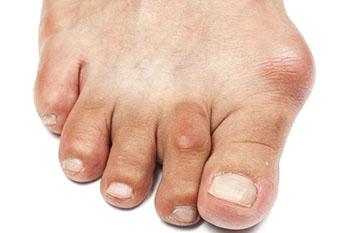 A bunion is a deformity of the big toe joint that results from bone misalignment or repositioning at the joint. Although bunions occur most frequently at the base of the big toe, they can also arise on the outside of the foot at the base of the small toe. Bunions can occur due to conditions such as overpronation, flat feet, neuromuscular foot problems, ill-fitting footwear, recurring stress to the foot, previous foot injuries, congenital defects, and arthritis.
A bunion is a deformity of the big toe joint that results from bone misalignment or repositioning at the joint. Although bunions occur most frequently at the base of the big toe, they can also arise on the outside of the foot at the base of the small toe. Bunions can occur due to conditions such as overpronation, flat feet, neuromuscular foot problems, ill-fitting footwear, recurring stress to the foot, previous foot injuries, congenital defects, and arthritis.
When the joint at the base of the big toe becomes enlarged, friction and pressure are created as it painfully rubs against footwear. Eventually, the big toe may press inward against the smaller toes, even overlapping as far as the third toe in some cases, a condition called hallux valgus. With some bunions, the big toe also rotates or twists inward, which is called hallux abducto valgus. Bunions can cause chronic pain and discomfort when walking, especially as the bunion becomes larger and rubs against footwear; swelling, redness, and tenderness at the site and thickened skin on the bottom of the affected area are also recurring problems with bunions.
Surgery to remove a bunion is called a bunionectomy. There are several types of bunionectomies due to the various structural changes of the foot caused by bunion deformities. Head procedure bunionectomies fix bunions and structural changes at the big toe joint by cutting the bone behind the joint, repositioning the joint, and fixing it in place with a pin.
Base procedure bunionectomies also treat the big toe joint; the procedure can vary based on the type of deformity being addressed and may involve toe ligaments as well. Wedges of bone can be removed from near or behind the big toe joint to allow the bone to be separated and repositioned. Semi-circular cuts can also be made so the bone can be rotated into proper position. Also, the joint can be fused.
Bunionectomies are usually performed as outpatient procedures under local anesthesia. The patient may have to walk with crutches to keep weight off of the affected foot, and a surgical shoe may be necessary for a few weeks.
Be sure to choose an experienced podiatrist or surgeon skilled specifically in bunionectomies due to the complexity of the procedure. Realize that bunions may return and foot structure may not be able to be fully returned to normal. Through removing bunions, deformities, structure alignment, and function can be greatly improved, but they may not be made perfect. Recovery after surgery can be a long process involving physical therapy and wearing orthotics on a permanent basis.
